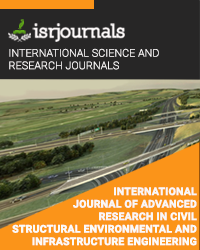structural biomimicry – evolving an efficient column
Lucky Rebecca Joseph,Satyanarayanan K. S
Published in International Journal of Advanced Research in Civil,Structural,Environmental and Infrastructure Engineering and Developing
ISSN: 2320-723X Impact Factor:1.7 Volume:1 Issue:3 Year: 08 April,2014 Pages:82-86

Abstract
Biomimicry is the discipline of science that studies models of nature and then imitates or inspiration of those designs, processes to solve human problems. Many engineering and architectural applications have learned from these natural processes to create buildings that are models of resource efficiency. Although present construction has included all requirements in seismic codes, there are still some design-construction principles that have to be optimized in order to improve building adaptation seismic events. Structures need to modify concurrently with ecological trends for reducing pollution associated with production. For this paper, such kind of resiliency standard is achieved focusing on structural design concept inspired by the performance and geometry efficiency of a static model bio-structure - human skeleton precisely femur, tibia and produce structural elements driven by the natural flow of force generated by an earthquake. Such kind of desired “force-driven form” found resemblance with bones. Human skeleton adapts according to function and loads that are normally encountered. This key idea of nature is mimicking to composite columns of framed structures, which should withstand both gravity and transverse loading of structural system. This paper is an initial part of ongoing research work and presents the results of analysis on tibia.
Kewords
Biomimicry, structural system, CT scan, femur bone, tibia bone, mimics, column
Reference
1) Amornsamankul S., Kaorapapong K., Wiwatanapataphee B. (2010), ‘Three-Dimensional Simulation of Femur Bone and Implant in Femoral Canal using Finite Element Method’, International Journal of Mathematics and Computers in Simulation, volume 4, pp 171-178. 2) Bredbenner T.L., Eliason T.D., Potter R.S., Mason R.L., Havill L.M., Nicolella D.P. (2010), ‘Statistical Shape Modeling Describes Variation in Tibia and Femur Surface Geometry Between Control and Incidence Groups From The Osteoarthritis Initiative Database’, Journal of Biomechanics, volume 43, pp. 1780–1786. 3) Cristofolini. L and Viceconti M. (2000), ‘Mechanical Validation of Whole Bone Composite Tibia Models,’ Journal of Biomechanics, Vol. 33, pp. 279-288. 4) Cristofolini L., Cappello A., Mc Namara B.P., Viceconti M. (2006), ‘A minimal parametric model of the femur to describe axial elastic strain in response to loads’, Journal of Medical Engineering and Physics Vol. 18, pp. 502-514. 5) Ehsan, Behrooz and Reza. (2011) ‘Mechanical Validation of Perfect Tibia 3D Model using Computed Tomography Scan’, Journal of Biomechanics, volume 77, pp. 1785–1789. 6) Gwun Jang I., Yong Kim, I. (2008), ‘Computational study of Wolff’s law with trabecular architecture in the human proximal femur using topology optimization’, Journal of Biomechanics, volume 41, pp. 2353–2361. 7) Jonkers I., Sauwen N., Lenaerts G., Mulier M., Perre G.V., Jaecques S. (2008), ‘Relation between subject-specific hip joint loading, stress distribution in the proximal femur and bone mineral density changes after total hip replacement’, Journal of Biomechanics, volume 41, pp. 3405–3413. 8) Kasiri S., Taylor D. (2008), ‘A critical distance study of stress concentrations in bone’, Journal of Biomechanics, volume 41, pp. 603–609. 9) Lengsfeld M., Schmitt J., Alter P., Kaminsky J., Leppek R. (1998), ‘Comparison of Geometry-Based and CT Voxel-Based Finite Element Modelling and Experimental Validation,’ Journal of Medical Engineering and Physics, volume 20, pp. 515–522. 10) Lengsfeld M., Kaminsky J., Merz B.,Franke R.P. (1996), ‘Sensitivity of Femoral Strain Pattern Analyses to Resultant and Muscle Forces at the Hip Joint’, Journal of Medical Engineering Physics, Vol. 18, pp. 70-78. 11) Materialise's Interactive Medical Image Control System (MIMICS) 10.01, User Manual, Materialise, http://www.materialise.com/mimics/ 12) Mc. Namara B.P., Cristofolini l., Toni A., Taylor D. (1997), ‘Relationship Between Bone-Prosthesis Bonding and Load Transfer in Total Hip Reconstruction’, Journal of Biomechanics, volume 30, pp 621-630. 13) Pal B., Gupta S., Andrew M.R., New Browne M. (2010), ‘Strain and micro motion in intact and resurfaced composite femur - Experimental and numerical investigations’, Journal of Biomechanics, volume 43, pp. 1923–1930. 14) Raji Nareliya, Veerendra Kumar. (2011), ‘Biomechanical Analysis of Human Femur Bone’ International Journal of Engineering Science and Technology (IJEST) Vol. 3, pp3091-3094.

